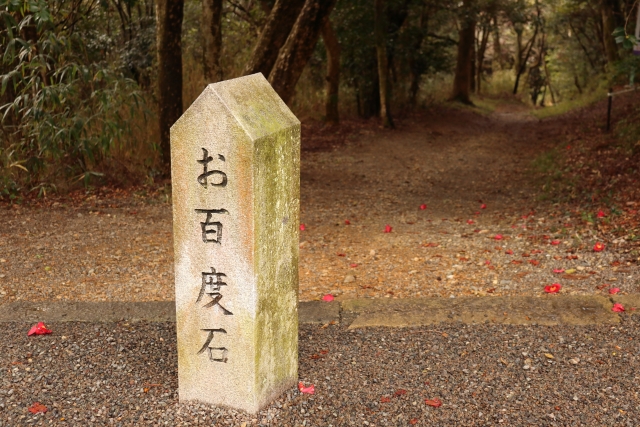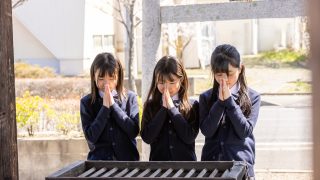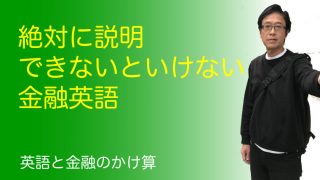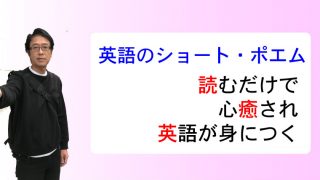「お百度参り」は、同じ神社やお寺を100回往復して願いを込める日本独特の祈願方法です。
一見すると不思議に思える習慣ですが、その背景には深い信仰心と日本人の精神性が込められています。
現代では実際に行う人は少なくなりましたが、「お百度を踏む」という表現は今でも日常会話で使われています。
本記事では、お百度参りの起源、実践方法、込められた意味、そして外国人に英語で説明する際のポイントまで徹底解説します。
日本の宗教文化に興味がある方、外国人に日本文化を紹介したい方は必見です。
お百度参りの基礎知識
お百度参りとは、願い事を叶えるために神社やお寺の本殿と鳥居(または門)の間を100回往復する日本の伝統的な祈願方法です。「百度」は100回を意味し、何度も繰り返し参拝することで願いの真剣さを神仏に示すとされています。
英文での紹介: “Ohyakudo-mairi is a traditional Japanese prayer practice where a person walks back and forth 100 times between the main hall of a shrine or temple and its entrance gate (torii or mon). The term ‘hyakudo’ means ‘100 times,’ and this repetitive act demonstrates the sincerity and seriousness of one’s wishes to the deities. It’s based on the belief that the more effort and dedication you show, the more likely your prayers will be answered.”
対訳: 「お百度参りは、神社や寺院の本殿と入口の門(鳥居または門)の間を100回往復する日本の伝統的な祈りの習慣です。『百度』という言葉は『100回』を意味し、この繰り返しの行為は神々に対する願いの誠実さと真剣さを示します。これは、より多くの努力と献身を示すほど、祈りが叶えられる可能性が高まるという信念に基づいています。」
お百度参りの歴史と起源
お百度参りの起源は平安時代にまで遡るとされています。もともとは貴族や僧侶が行っていた修行の一種でしたが、江戸時代になると庶民の間にも広まりました。特に病気治癒や家族の無事を願う切実な願い事をする際に行われることが多くありました。
英文での紹介: “The origins of ohyakudo-mairi trace back to the Heian period (794-1185). Initially, it was a form of ascetic practice performed by aristocrats and Buddhist monks. During the Edo period (1603-1868), the custom spread to common people, who adopted it as a way to make desperate prayers for serious matters like healing the sick, ensuring family safety, or seeking divine intervention in life-or-death situations. The physical exertion involved was seen as proof of one’s devotion and willingness to endure hardship for the sake of their wish.”
対訳: 「お百度参りの起源は平安時代(794-1185年)にまで遡ります。当初は、貴族や仏教僧が行う苦行の一形態でした。江戸時代(1603-1868年)には、この習慣が一般庶民にも広まり、病人の治癒、家族の安全確保、または生死に関わる状況での神の介入を求めるなど、深刻な問題について必死の祈りをする方法として採用されました。伴う肉体的な労力は、自分の献身と願いのために困難に耐える意志の証と見なされました。」
お百度参りの実践方法
お百度参りには決まった作法があります。まず「百度石」と呼ばれる目印の石の前に立ち、一礼してから本殿へ向かいます。本殿で祈願したら百度石に戻り、これを100回繰り返します。数を数えるために小石や竹串を使うこともあります。
英文での紹介: “There’s a specific procedure for ohyakudo-mairi. First, you stand before a marker stone called ‘hyakudo-ishi’ (hundred-times stone), bow, and then walk to the main hall to pray. After offering your prayer, you return to the stone. This process is repeated 100 times. To keep count, practitioners often use small pebbles or bamboo sticks, moving one from a pile each time they complete a round. Traditionally, this practice should be completed in a single visit, which can take several hours. Some devotees perform it barefoot, adding physical discomfort to demonstrate their earnestness.”
対訳: 「お百度参りには特定の手順があります。まず、『百度石』と呼ばれる目印の石の前に立ち、お辞儀をしてから本殿に歩いて祈ります。祈りを捧げた後、石に戻ります。このプロセスを100回繰り返します。数を数えるために、参拝者はしばしば小石や竹串を使用し、1回往復するたびに山から1つ移動させます。伝統的には、この習慣は1回の訪問で完了すべきで、数時間かかることがあります。一部の信者は裸足で行い、真摯さを示すために肉体的な不快感を加えます。」
お百度参りに込められた精神性
お百度参りは単なる迷信ではなく、日本人の「一所懸命」「誠心誠意」という価値観を体現した行為です。100回という回数には、完全性や達成感を表す意味があり、願いを叶えるために自らの身体を通じて努力する姿勢が重視されています。
英文での紹介: “Ohyakudo-mairi embodies core Japanese values like ‘isshoukenmei’ (doing one’s utmost) and ‘seishin-seii’ (wholehearted sincerity). The number 100 symbolizes completeness and totality in Japanese culture. The practice demonstrates that true wishes require personal sacrifice and physical commitment—not just words. It reflects the Buddhist concept that suffering and perseverance purify one’s intentions and make prayers more worthy of divine attention. The physical exhaustion experienced becomes a meditation in motion, allowing the practitioner to focus entirely on their wish while emptying their mind of distractions.”
対訳: 「お百度参りは、『一所懸命』(全力を尽くす)や『誠心誠意』(心からの誠実さ)といった日本の核となる価値観を体現しています。100という数字は、日本文化において完全性と全体性を象徴します。この習慣は、真の願いには個人的な犠牲と肉体的な献身が必要であり、言葉だけではないことを示しています。これは、苦しみと忍耐が意図を浄化し、祈りをより神の注目に値するものにするという仏教の概念を反映しています。経験する肉体的疲労は動く瞑想となり、実践者が気を散らすものを心から空にしながら、完全に願いに集中できるようにします。」
現代のお百度参り
現代では実際にお百度参りを行う人は少なくなりましたが、その精神は今も生きています。「お百度を踏む」という慣用句は、何度も繰り返し訪問したり交渉したりすることを意味し、ビジネスシーンでも使われます。また、一部の神社では今でも百度石が残されています。
英文での紹介: “In modern Japan, fewer people actually perform ohyakudo-mairi, but its spirit lives on. The expression ‘ohyakudo wo fumu’ (to tread the hundred times) has become an idiom meaning to repeatedly visit or petition someone, often used in business contexts when negotiating or making sales calls. Some shrines still maintain their hyakudo-ishi stones as historical markers. When ohyakudo-mairi is performed today, it’s usually for extremely serious matters such as praying for recovery from critical illness or success in life-changing endeavors. The practice has also appeared in Japanese popular culture, including novels, films, and manga, often depicting characters performing it as an act of desperate devotion.”
対訳: 「現代日本では、実際にお百度参りを行う人は少なくなりましたが、その精神は生き続けています。『お百度を踏む』という表現は、誰かを繰り返し訪問したり嘆願したりすることを意味する慣用句となり、交渉や営業訪問の際のビジネスシーンでよく使われます。一部の神社では、今でも歴史的な目印として百度石が維持されています。今日お百度参りが行われる場合、通常は重病からの回復や人生を変える試みの成功を祈るなど、極めて深刻な問題のためです。この習慣は、小説、映画、漫画を含む日本のポップカルチャーにも登場し、しばしば必死の献身の行為としてキャラクターが行う様子が描かれています。」
外国人に伝える際の文化的ポイント
お百度参りを外国人に説明する際は、西洋の巡礼との類似点や相違点を示すと理解されやすくなります。また、日本の「形から入る」精神文化や、願いを叶えるための努力の重要性についても触れると良いでしょう。
英文での紹介: “When explaining ohyakudo-mairi to Westerners, it helps to compare it to pilgrimage traditions found in Christianity, such as walking the Camino de Santiago, but emphasize that ohyakudo-mairi is concentrated in one location rather than a long journey. You can explain it as a form of ‘active meditation’ or ‘prayer through movement.’ It’s important to note that this practice reflects the Japanese belief that sincerity must be demonstrated through action, not just spoken words. The concept might seem superstitious to some, but it’s better understood as a psychological and spiritual discipline—the repetitive physical act helps focus the mind and demonstrates commitment to one’s goal, similar to how athletes train through repetitive practice.”
対訳: 「お百度参りを西洋人に説明する際は、サンティアゴ・デ・コンポステーラを歩くなど、キリスト教に見られる巡礼の伝統と比較すると役立ちますが、お百度参りは長い旅ではなく一つの場所に集中していることを強調してください。『アクティブな瞑想』または『動きを通じた祈り』の一形態として説明できます。この習慣は、誠実さは言葉だけでなく行動を通じて示されなければならないという日本の信念を反映していることに注意することが重要です。この概念は一部の人には迷信的に思えるかもしれませんが、心理的および精神的な修練としてより良く理解されます。繰り返しの肉体的行為は心を集中させ、目標への献身を示すのに役立ちます。アスリートが繰り返しの練習を通じてトレーニングするのと似ています。」
お百度参りと関連する日本の信仰習慣
お百度参りと似た習慣として、千羽鶴を折る習慣や、お遍路さん(四国八十八か所巡礼)があります。これらはすべて、願いを叶えるために時間と労力を捧げるという共通の精神性を持っています。
英文での紹介: “Ohyakudo-mairi shares spiritual kinship with other Japanese practices like folding 1,000 origami cranes (senbazuru) for healing wishes, or undertaking the 88-temple pilgrimage in Shikoku (ohenro-san). All these practices embody the principle that achieving something important requires dedicated effort and time. They reflect a cultural understanding that the journey itself—not just the destination—has transformative power. This philosophy contrasts with instant-gratification cultures and demonstrates the Japanese appreciation for process, perseverance, and the accumulation of small efforts toward a greater goal.”
対訳: 「お百度参りは、治癒の願いのために1,000羽の折り鶴(千羽鶴)を折る習慣や、四国の88の寺院巡礼(お遍路さん)を行うことなど、他の日本の習慣と精神的な親近性を共有しています。これらすべての習慣は、重要なことを達成するには献身的な努力と時間が必要であるという原則を体現しています。それらは、目的地だけでなく旅そのものが変容する力を持つという文化的理解を反映しています。この哲学は即座の満足を求める文化とは対照的で、プロセス、忍耐、そしてより大きな目標に向けた小さな努力の積み重ねに対する日本人の評価を示しています。」
まとめ
お百度参りは、日本人の信仰心と精神性が凝縮された伝統的な祈願方法です。平安時代から続くこの習慣は、願いを叶えるには言葉だけでなく、身体を通じた努力と献身が必要であるという日本的価値観を体現しています。
現代では実際に行う人は減少しましたが、「お百度を踏む」という表現は今も使われ、その精神は日本文化の中に生き続けています。外国人にお百度参りを紹介する際は、単なる迷信としてではなく、誠実さを行動で示す日本の文化的特徴として説明することで、より深い理解を促すことができます。日本の宗教文化の奥深さを伝える貴重な例として、お百度参りは今後も多くの人々の関心を集め続けるでしょう。
外資系企業への英語面接サポート・サービスで不安を解消しましょう!
stephenpong.com では、おひとりおひとりに合わせて
英語面接のサポートをレジュメの作成段階からご指導致します
まずは、お問い合わせください
自分で用意した英文レジュメはこれでいいのかな?
英語面接の質問とその答え方はどう準備したらいいの?
英語の面接に不安を感じる、模擬面接で練習したい?!
これらのお悩みをすべて解決します!
お気楽に下記フォームからご相談ください!
人生を動かしましょう!
ごく稀に、返信メールがお客様の迷惑フォルダに紛れ込んでいる場合がありますのでご注意ください。
















